September 16, 2016 @ 3:30 pm - 4:30 pm
Event Navigation
Understanding Structure-Property Relationships of Grain Boundaries and Interfaces for Materials Design
Dr. Mark A. Tschopp, Army Research Laboratory, Lightweight and Specialty Metals Branch, Materials and Manufacturing Division
Grain boundaries and interfaces play a commanding role in the bulk properties of polycrystalline materials, interacting with dislocations and/or cracks, absorbing defects and solute atoms, and moving with stress and/or temperature. Suffice it to say that understanding the structure-property relationships of grain boundaries and interfaces in metals and ceramics is critical to designing material systems for improved properties and performance. This presentation will introduce the different kinds of grain boundaries and interfaces in metals/ceramics and discuss some recent research thrusts to understand grain boundary/interfacial behavior, to model these grain boundaries/interfaces, and to experimentally tailor these grain boundaries/interfaces for real material systems. The understanding of interfaces, in particular the structure-property relationships, is a key component of the “Materials-By-Design” thrust – a concept related to national initiatives to develop integrated computational material models that aim to link chemistry and processing all the way to performance, with everything in between. The ability to model these interfaces can provide insight into material behavior at multiple scales. This talk will focus on the many efforts to understand, model, and engineer grain boundaries in polycrystalline metals and ceramics, to include efforts (1) to sample how properties are influenced by grain boundary character, (2) to develop methods to obtain grain boundaries in simple (cubic) and complex systems, (3) to understand how grain boundary structure interacts with dislocations, point defects, solutes, and impurities, (4) to mathematically describe how shear (twinning dislocations) and shuffles impact twinning in HCP metals, (5) to engineer the thermal stability of nanocrystalline alloys via solute additions, (6) to radically improve the properties of bulk nanocrystalline parts by dispersing nanosized precipitates, and (7) to navigate the complexity in modeling grain boundaries in lightweight armor ceramics such as boron carbide. Or, perhaps I’ll just talk about a few of these topics…
Seminar will be held in Malone Hall, G33/35 at 3:30 PM.




